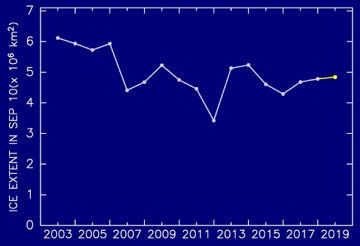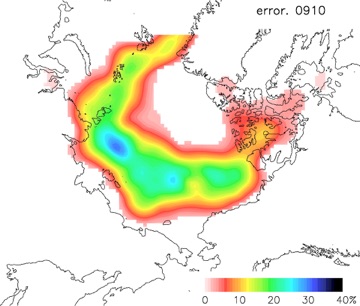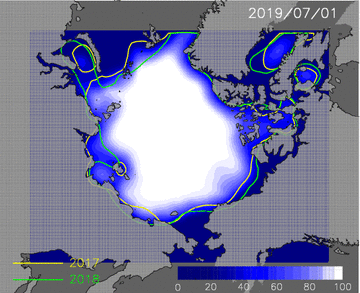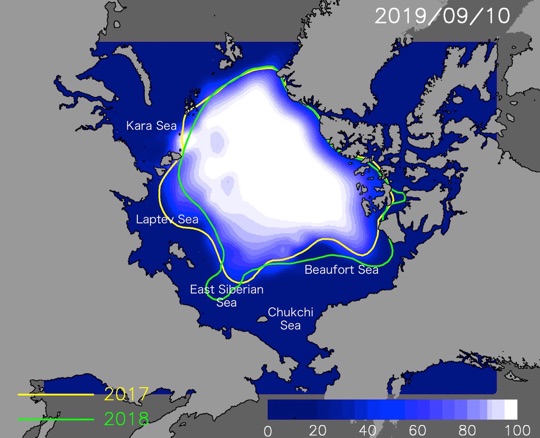


Arctic Sea Ice Forecast 2019
First Report:May 16, 2019
Noriaki Kimura, Hiroyasu Hasumi
Atmosphere and Ocean Research Institute, The University of Tokyo
Figure1:Predicted sea ice cover on September 10, 2019.
-
1.Minimum ice extent will be about 4.80 million square kilometers.
-
2.Ice retreat in the Beaufort Sea and New Siberian Islands will be faster than a normal year.
-
3.Ice retreat in the Kara Sea and Severnaya Zemlya will be slower than a normal year.
-
4.Sea routes of Russian side will open around August 15, and the Canadian side except for Canadian archipelago will open around July 17.
This work was supported by
Arctic Challenge for Sustainability Project.
If you have any questions, please contact kimura_n@aori.u-tokyo.ac.jp
Figure 2:The interannual change of minimum extent since 2003. Value of 2019 is predicted one.
Figure 3:Animation of predicted Arctic ice extent from the July 1 to the September 20. Yellow and green lines indicates the ice edge of the same day for 2017 and 2018.
Figure 4:Animation of the daily anomaly of the predicted ice concentration from 2003-2018 mean. Red color shows the area of faster ice retreat.
Sea ice extent on September 10 is expected to be 4.84 million square kilometers, which is 1.2% larger than the last year’s minimum area.
Though ice cover in the East Siberian Sea will retreat with nearly same speed as a normal year, ice retreat around the New Siberian Islands (Islands between the East Siberian Sea and Laptev Sea) will be faster than a normal year. On the other hand, the retreat speed in the Kara Sea and Severnaya Zemlya (Islands between the Kara Sea and Laptev Sea) will be slower than a normal year.
Sea routes of the Russian side will open around August 15.
Ice retreat in the Beaufort Sea will be faster than a normal year.
Sea routes of the Canadian side except for Canadian archipelago will open around the July 17, which is earlier than the last year.
-----
For this prediction, we used the sea ice data from satellite microwave sensors AMSR-E and AMSR2, and the relationship between the winter ice motion and summer ice concentration (Kimura et al., 2013). In this report, we use the data until April 30.
-----
Ice prediction map is also available in Arctic Data Archive System of National Institute of Polar Research.
Figure 5:Estimated error of the predicted ice concentration on September 10.



